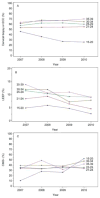Cervical excisional treatment of young women: a population-based study
- PMID: 24395062
- PMCID: PMC3992337
- DOI: 10.1016/j.ygyno.2013.12.037
Cervical excisional treatment of young women: a population-based study
Abstract
Objective: Assessment of cytology and biopsy results preceding cervical excisional treatment and their association with excisional histology, to evaluate compliance with treatment recommendations and the potential effect of revisions in cervical histology terminology and usage.
Method: Data from a unique statewide population-based screening registry was used to describe the use and histologic outcomes of cervical excisional procedures in the year following an abnormal cervical screening cytology.
Results: From 2007 to 2011, LEEP rates decreased 87%, 45%, and 16% for women aged 15-20, 21-24, and 25-29 years, respectively. Reductions were attributable to an overall decline in cervical screening and colposcopy, and a decrease in LEEP following a diagnosis of less than cervical intraepithelial neoplasia grade 2 (<CIN2) or CIN2 histology preceded by any abnormal cytology other than high-grade squamous intraepithelial lesion (<HSIL). LEEP rates did not change significantly (p>0.7) for women aged 30-39 years. Irrespective of age, CIN2 was the most common histologic antecedent of excisional treatment (42%), with most (80%) preceded by <HSIL cytology.
Conclusion: Cervical excisions are an unavoidable consequence of cervical screening. Adherence to treatment guidelines stipulating conservative follow-up of young women with biopsies ≤CIN2 could significantly decrease the number of excisional procedures and associated harms. This opportunity will be lost if cervical intraepithelial neoplasia grade 3 (CIN3) and some or all of CIN2 are merged into a single histologic category, as has been recently recommended in the United States.
Keywords: Adherence to cervical treatment guidelines; Cervical intraepithelial neoplasia grades 2 and 3 (CIN2 and CIN3); Cervical screening; Colposcopy; Effectiveness and harms of cervical screening; Loop electrosurgical excision procedure (LEEP).
Copyright © 2013 The Authors. Published by Elsevier Inc. All rights reserved.
Conflict of interest statement
The authors report no conflicts of interest.
Figures


References
-
- Moyer VA on behalf of the U S. Preventive Services Task Force. Screening for Cervical Cancer: U.S. Preventive Services Task Force Recommendation Statement. Ann Intern Med. 2012;156:393–3. - PubMed
-
- ACOG Committee on Practice Bulletins--Gynecology. ACOG Practice Bulletin no 109: Cervical cytology screening. Obstet Gynecol. 2009;114:1409–20. - PubMed
-
- American College of Obstetricians and Gynecologists. ACOG Committee Opinion No 463: Cervical cancer in adolescents: screening, evaluation, and management. Obstet Gynecol. 2010;116:469–72. - PubMed
Publication types
MeSH terms
Grants and funding
LinkOut - more resources
Full Text Sources
Other Literature Sources
Medical

